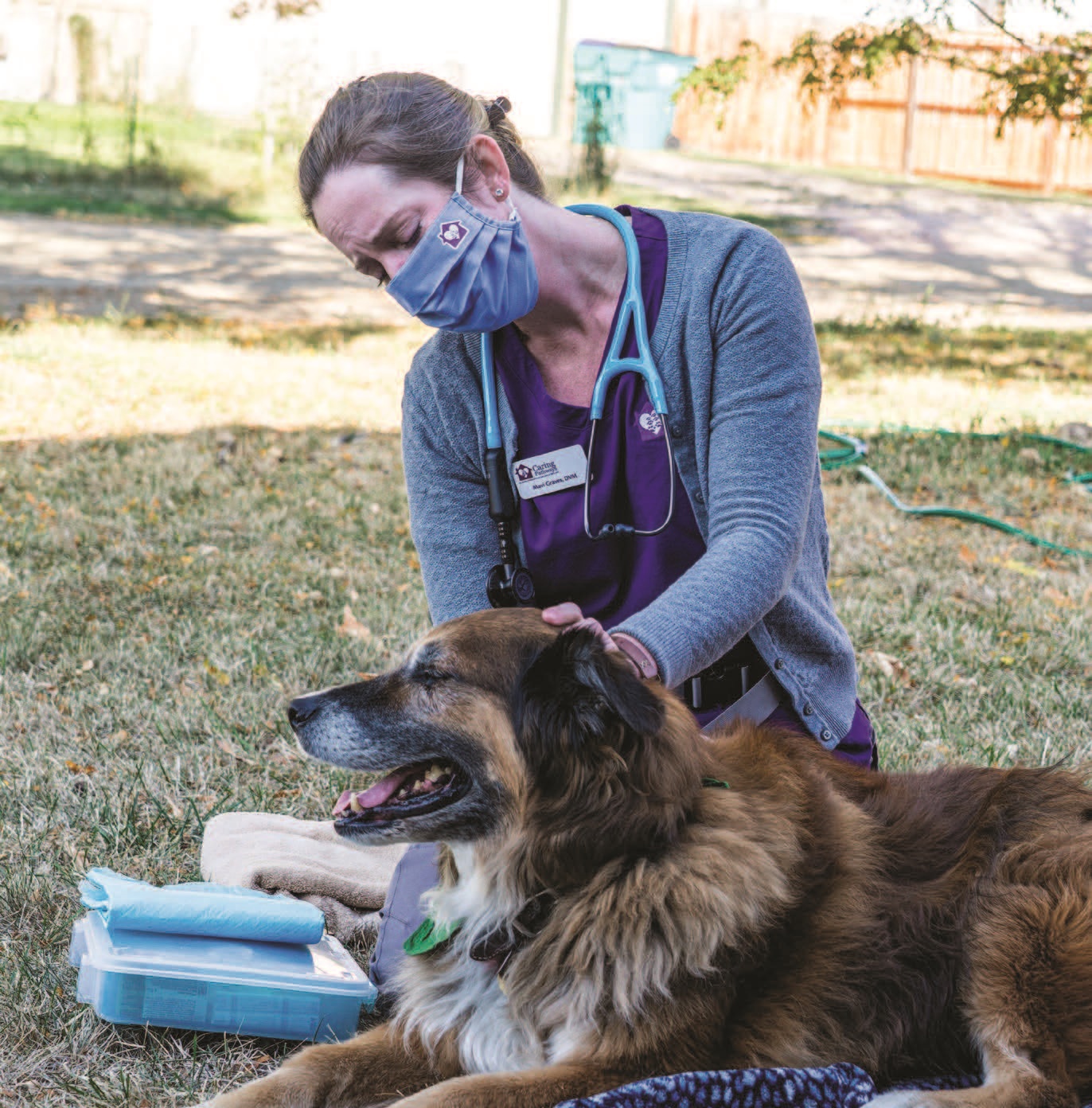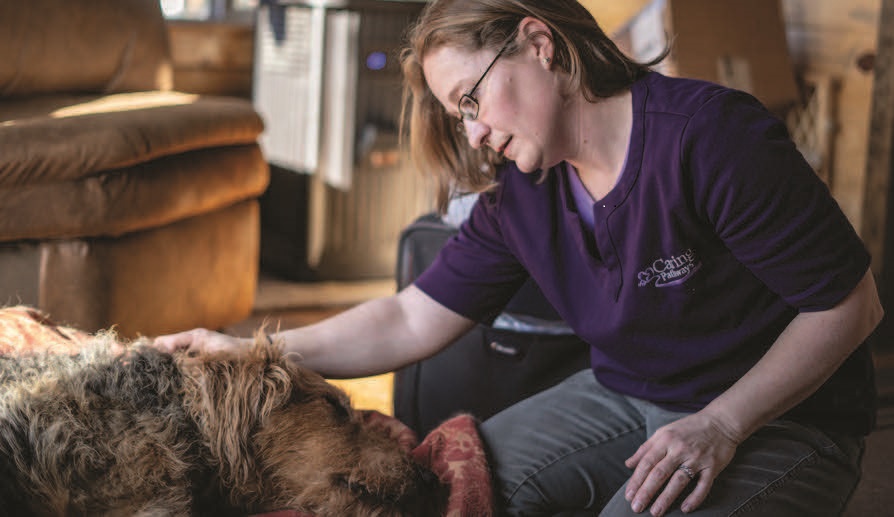How Accreditation Will Change End-of-Life Veterinary Care
AAHA Accreditation Has Arrived in an Industry That Needed It
by Sarah Ratliff
IN SEPTEMBER 2020, AAHA ANNOUNCED IT WAS LAUNCHING a new and highly specialized accreditation program for veterinary practices that specialize in end-of-life care (EOLC). The AAHA End-of-Life Care program includes practices that offer mobile (in-home) or clinic-based euthanasia services, support for animal hospice care, or palliative care programs administered by pet owners.
 Caring Pathways veterinarian Mavi Graves,
Caring Pathways veterinarian Mavi Graves,
DVM, performing a hospice appointment in a client’s front yard.
The first veterinary practice to seek and receive AAHA end-of-life care accreditation is Colorado-based Caring Pathways, which specializes in mobile euthanasia services and hospice consulting in the Denver area. “This accreditation is very different from anything that we’ve ever offered before,” said Margaret Spalletta, CVT, an AAHA veterinary consultant who evaluated Caring Pathways. “We have never developed a very integrated network of standards specifically for one of our areas of interest. We’ve learned a lot, and we’re very proud of this model because it’s going to help our traditional practices and our mobile veterinarians. We’re going to be bringing this to such a wider array of people in the industry than we ever have before.”
When facing dire health situations, many pet owners prefer to keep their animals in the home environment where anxiety is reduced for the animals and for their human families. This creates a fresh set of challenges for veterinarians, who for the most part aren’t specifically trained to work in the field caring for sick, injured, or aging animals.
Mobile veterinary care has been around for years, but now mobile end-of-life care is a rapidly growing niche, which prompted AAHA to respond.
“AAHA recognized that the mobile end-of-life industry was growing rapidly without a lot of oversight,”
explained Kathleen Cooney, DVM, CHPV, CCFP, who helped AAHA draw up the 2016 AAHA/IAAHPC End-of- Life Care Guidelines. “AAHA created the standards to provide some of that oversight, helping these mobile end-of-life services blend together the wonderful things that hospitals have been doing for so long and making sure that the fundamentals for pain management were there and that there are good employee manuals in place.”
This accreditation is not available to practices that offer euthanasia or hospice care support as a part of a comprehensive menu of services. They must provide end-of-life care exclusively or have a separate department solely dedicated to providing it.
Navigating the AAHA Accreditation Rules
The AAHA end-of-life care accreditation standards do not include the strict protocols for “normal” accreditation. Individual veterinarians maintain their autonomy to customize services as they see fit and according to client needs. What the AAHA standards do is set parameters to make sure practices are acting responsibly and are offering pets and pet owners the very best in modern evidence-based medical services.
As an example of the latter consideration, end-of-life veterinary care practices must administer sedatives to animals before euthanasia can be performed. “We have a set of mandatory standards they must adhere to; those are black and white,” Spalletta said. “If they answered ‘no’ to that standard, it would make it very hard for them to pass anesthesia. Therefore, they would not be able to be accredited for end-of-life.”
 Caring Pathways veterinarian Megan
Caring Pathways veterinarian Megan
Coveyou, DVM, providing compassionate
end-of-life pet care for a client in the comfort of their own home.
AAHA practice consultants rely on guidelines for end-of-life care that the association developed in cooperation with the International Association for Animal Hospice and Palliative Care (IAAHPC) in 2016. AAHA has an ongoing relationship with the IAAHPC, which offers a comprehensive certificate training program for veterinarians who’d like to specialize in animal hospice care.
Currently, all evaluations for accreditation are being performed remotely. This method works quite well for both sides, as AAHA practice consultants can observe veterinarians in action without causing any distraction.
Caring Pathways Earns First-Ever EOLC Accreditation
In business since 2010, Caring Pathways offers mobile euthanasia services to pet owners in the greater Denver metropolitan area and beyond. They also consult with pet owners interested in home-administered hospice care for their terminally ill cats and dogs.
“We’re really excited to be the first AAHA-accredited end-of-life care practice,” said Chelsea McGivney, DVM, the Caring Pathways general manager. “Caring Pathways has worked really, really hard to pioneer the way when it comes to excellent at-home end-of-life care. This is something our team is really proud of, and to make sure that we continue to grow and improve, we’re going to keep working with AAHA to continue meeting the accreditation standards.”
Caring Pathways is exclusively mobile. All the euthanasia procedures occur in pet owners’ homes or other special environments that pet owners request. In some cases, the practice also helps clients design animal hospice care plans, and their trained veterinarians will continue monitoring those plans once they’re implemented. They provide essential auxiliary services to pet owners as well, including grief counseling and assistance with after-death cremation or burial. Caring Pathways takes responsibility for every aspect of a euthanasia procedure, relieving their clients of the need to handle difficult tasks at an emotionally trying time in their lives.
“A big part of what we do is interacting with the clients— not just the veterinarians that go into the homes but, of course, our client care team,” McGivney said. “They’re the ones who are on the phone, scheduling those appointments. They get to be the first impression of the company, walking the client through what the experience is going to be like. I would say everybody on the team has a really important role in creating the most positive experience out of a really hard situation.”
Caring Pathways helps translate the best intentions of pet owners into meaningful action, McGivney believes. “It really celebrates that human-animal bond,” she said of her company’s services. “These pets become our family members, and you realize that when you’re able to help a family say goodbye to this family member in the comfort of their home.”
Caring Pathways recently hired Cooney as their Chief Medical Officer. In addition to being on the AAHA end-of-life care guidelines task force, she is a past president of IAAHPC and also founded the Companion Animal Euthanasia Training Academy in 2017.
|
|
AAHA End-of-Life Care Resources |
|---|---|
|
The 2016 AAHA/IAAHPC End-of-Life You can also learn more about EOLC accreditation at aaha.org/EOLC |
|
Despite the coincidental timing, Caring Pathways didn’t hire Cooney specifically to help them achieve AAHA accreditation. “Caring Pathways brought me on because of my wealth of experience in end-of-life care for pets,” Cooney said. “I’m very well known for my pioneering work in this space with animal hospice, palliative medicine, and euthanasia.”
There was a confluence of interest between Cooney’s work and the needs of Caring Pathways. Responding to industry trends, they hope to leverage her expertise in animal hospice care to expand that part of their business. They also hired her to help them complete the next phase of their development, as they seek to form partnerships or franchise-style relationships with other end-of-life care veterinary practices nationwide.
“We are looking for quality end-of-life services around the US that can benefit from joining forces with Caring Pathways,” she said. “We’re looking to acquire services that can use Caring Pathways’ expertise from the business side of things and the medical side.”
“That’s one approach, and the other approach is to identify those communities that are underserved with end-of-life mobile support, and then we can start up new Caring Pathways ventures in those areas,” she continued. In cases like these, Cooney confirms that local veterinarians will be recruited to join the extended Caring Pathways family, creating company satellites in new locations.
Caring Pathways is anxious to spread their brand name quickly now that they’ve gained special prestige by becoming the first veterinary practice to secure AAHA end-of-life accreditation. This is an advantage Cooney plans to pass on to company affiliates.
“When we’ve got a service that is interested in joining the Caring Pathways family, part of my due diligence is to spend time with them and see where they’re at with things,” she explained, “so that we can understand what it’s going to take to get them up to Caring Pathways level standards and AAHA level standards, which we think is really good for veterinary medicine in the industry.” In this sector of veterinary practice, authoritative oversight has long been lacking. If an established company with a nationwide presence can convince clients they’ll be getting the best available end-of-life care for their pets, that company will enjoy a significant marketing advantage over its competitors. In the meantime, the reputation of the end-of-life care industry as a whole will be enhanced.
This can all be an outgrowth of AAHA end-of-life care accreditation, which Caring Pathways has all to themselves for the time being. Easing the Pain of Euthanasia Most pet owners can tell when their animal companions are ready to move on. But in most instances, they will still want to talk things over with their veterinarian to make sure they’ve exhausted every possibility and have no other option to stop their loved one’s suffering. They may want their veterinarian to perform one last evaluation of their pet to make sure there is no other humane option available.
“There are absolutely signs to watch for,” said Spalletta, explaining how veterinarians with end-of-life care expertise will proceed when asked to evaluate a sick or aging pet. “They can be very hidden at times, and they can also be very obvious. Usually, if they’re just not acting themselves, if they’re just really depressed, just kind of down and out, energy levels can kind of go by the wayside. They’re not themselves.”
Pet owners will have often noticed these things, but hearing them confirmed by a trained expert will make them feel more secure in their judgment that euthanasia may be the best choice. Even in the home environment, when the moment arrives, it can be an incredibly difficult process for the pet owner to handle. At these times, the veterinarian must be both empathic and composed.
“It’s just being in the moment, trying to stay calm and professional,” Spalletta explained. “It’s about keeping the pet as comfortable as possible because they may be in pain, or they may be in and out of consciousness. They may have just been given the sedative and they’re dysphoric, they’re not able to be cognizant, and it’s very hard for the pet owner to see their pet in that frame of mind.”
“That’s one of the things that we are trying to help with,” she continued, speaking of AAHA practice consultants like herself who work with veterinarians seeking advice on how best to manage an in-home euthanasia procedure. “It’s just the communication surrounding the euthanasia process and how it should go.”
Caring Pathways is highly sensitive to the emotional needs of both pet parents and their animals, which is why they chose the mobile model over traditional office-based euthanasia services.
“One of the benefits is that not only the pet’s last memories but also the family’s last memories of their pet don’t have to be of a sterile vet clinic or an unfamiliar environment,” said McGivney. “Everybody can be comfortable.”
In one IAAHPC survey, 40% of pet owners said they would not return to their veterinarians following a negative euthanasia outcome. The new AAHA accreditation program is designed to make sure this problem is avoided by guaranteeing that practices will manage these procedures professionally, sensitively, and compassionately for the benefit of pet owners and their animal companions alike. The Animal Hospice or Palliative Care Alternative Animal hospice care is not a new concept. But this option remains unfamiliar to many pet owners.
The hospice care option offers an alternative to immediate euthanasia. Care plans are designed by veterinarians but only following careful consultations with the pet owners who request them.
There are several reasons why pet owners may ask veterinarians about animal hospice care:
- While they may be intellectually prepared for their pet’s death, emotionally, they may not be ready to consider euthanasia just yet
- They may want to be more directly involved in offering care for their pets, believing they can get better results or make their pets feel more comfortable
- They may want to protect their pets (and to some extent themselves) from the constant stress involving going to the clinic for frequent appointments
- They may want their pets’ last days or weeks to be as relaxing and pain-free as possible • They may want to try something different, feeling that current treatment plans aren’t producing the maximum possible results
- They may no longer be able to afford to pay for expensive clinical procedures and medications
- They may want to allow their pets to have a pain-free yet still natural death as an alternative to euthanasia
At Caring Pathways, personalized, in-home hospice treatment routines are worked out in advance during consultations between veterinarians and family members. The process begins with an initial assessment.
“We do offer in-home hospice and palliative care appointments,” McGivney explained, “if a family isn’t sure and they want to have their pet evaluated by a veterinarian, or if they know they’re just not ready yet but they want their pet to be kept as comfortable as possible, the veterinarian can go into the home, not just to evaluate the pet but to evaluate the environment and make recommendations around medication modifications to keep the pet as comfortable as possible.”
A veterinarian’s involvement will continue after hospice care begins. They will make regular follow-up visits and recommendations for adjustments in treatment protocols that can further relieve an animal’s pain or otherwise make their lives more convenient. If it becomes clear that the animal’s quality of life is worsening and that palliative care is only prolonging their suffering, they will speak to the family about their concerns in the most gentle and compassionate way possible.
When asked about how long an animal hospice care program usually lasts, Chelsea McGivney said that with her company, “it’s typically pretty short, usually just a couple of weeks between the time the client calls us to come in and evaluate the environment to when they’re ready to say goodbye. But it can be up to six months. It’s at the point when the families decide they no longer want to pursue further diagnostics, and they aren’t going to be pursuing expensive therapies. They really just want to keep their pet as comfortable as possible, so typically not very long.”
Accreditation Means Transformation, One Practice at a Time
There are approximately 135 million dogs and cats currently residing in American households (and tens of millions of other animals as well). According to statistics compiled by the market research firm IBIS World, in 2021, there were only 2,647 veterinary practices in the United States offering animal hospice care services, which averages out to 1 service for every 51,000 dogs and cats. This statistic shows that the niche is underserved, which means that the number of practices exclusively offering end-of-life care services will likely grow at an accelerated pace in the years ahead. This should make AAHA accreditation all the more valuable as veterinary practices in this specialty area search for ways to gain an edge over the increasing competition.
This new form of accreditation may also have an impact on related animal care practices down the road. “These standards will help the animal hospice and end-oflife industry in a broader sense,” Cooney predicts. “That might be in senior rescues, geriatric rescues, hospice rescues, or shelters. Those are out there across the United States, and they don’t have a lot of oversight. People can look upon what AAHA built and say, ‘alright, what do we learn from that?’ Then we can start to do some audits and monitoring of services that might otherwise not have a lot of monitoring. That’s going to be really good for patient welfare and certainly for industry protection.”
The end-of-life care industry is entering a new phase that should benefit veterinary practices and pet owners equally. Accreditation means much greater quality control—a type that consumers of these services are eventually going to demand.
 |
Sarah Ratliff and her husband live on an organic farm on the Caribbean island of Puerto Rico. She feels fortunate to call herself a corporate America escapee turned eco-organic farmer, writer, and published book author. |
Photo credits: Photos courtesy of Josh Lewis



